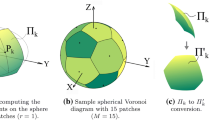Abstract
In this work, we propose and investigate a user-centric framework for the delivery of omnidirectional video (ODV) on VR systems by taking advantage of visual attention (saliency) models for bitrate allocation module. For this purpose, we formulate a new bitrate allocation algorithm that takes saliency map and nonlinear sphere-to-plane mapping into account for each ODV and solve the formulated problem using linear integer programming. For visual attention models, we use both image- and video-based saliency prediction results; moreover, we explore two types of attention model approaches: (i) salient object detection with transfer learning using pre-trained networks, (ii) saliency prediction with supervised networks trained on eye-fixation dataset. Experimental evaluations on saliency integration of models are discussed with interesting findings on transfer learning and supervised saliency approaches.





Similar content being viewed by others
References
Abbas, A., Adsumilli, B.: AhG8: new GoPro test sequences for virtual reality video coding. Technical Report JVET-D0026, JTC1/SC29/WG11, ISO/IEC, Chengdu, China (2016)
Asbun, E., He, H., Y., H., Ye, Y.: AhG8: InterDigital test sequences for virtual reality video coding. Technical Report JVET-D0039, JTC1/SC29/WG11, ISO/IEC, Chengdu, China (2016)
Bang, G., Lafruit, G., Tanimoto, M.: Description of 360 3D video application exploration experiments on divergent multiview video. Technical Report MPEG2015/ M16129, JTC1/SC29/WG11, ISO/IEC, Chengdu, China (2016)
Cornia, M., Baraldi, L., Serra, G., Cucchiara, R.: A Deep Multi-Level Network for Saliency Prediction. In: International Conference on Pattern Recognition (ICPR) (2016)
Fan, C.L., Lo, W.C., Pai, Y.T., Hsu, C.H.: A survey on \(360^\circ \) video streaming: acquisition, transmission, and display. ACM Comput. Surv. 54, 1–36 (2019)
Fang, Y., Chen, Z., Lin, W., Lin, C.W.: Saliency detection in the compressed domain for adaptive image re-targeting. IEEE Trans. Image Process. 21(9), 3888–3901 (2012). https://doi.org/10.1109/TIP.2012.2199126
Fang, Y., Wang, Z., Lin, W., Fang, Z.: Video saliency incorporating spatiotemporal cues and uncertainty weighting. IEEE Trans. Image Process. 23(9), 3910–3921 (2014). https://doi.org/10.1109/tip.2014.2336549
Hadizadeh, H., Bajić, I.V.: Saliency-aware video compression. IEEE Trans. Image Process. 23(1), 19–33 (2014). https://doi.org/10.1109/TIP.2013.2282897
Imamoglu, N., Zhang, C., Shimoda, W., Fang, Y., Shi, B.: Saliency detection by forward and backward cues in deep-CNNs. In: 2017 IEEE International Conference on Image Processing (ICIP) (2017)
Intel: Experience the Future of the Olympic Games with Intel (2018). https://www.olympic.org/news/experience-the-future-of-the-olympic-games-with-intel
Jiang, M., Huang, S., Duan, J., Zhao, Q.: Salicon: saliency in context. In: The IEEE Conference on Computer Vision and Pattern Recognition (CVPR) (2015)
Kan, N., Zou, J., Tang, K., Li, C., Liu, N., Xiong, H.: Deep reinforcement learning-based rate adaptation for adaptive 360-degree video streaming. In: ICASSP 2019–2019 IEEE International Conference on Acoustics, Speech and Signal Processing (ICASSP), pp. 4030–4034 (2019)
Li, C., Xu, M., Jiang, L., Zhang, S., Tao, X.: Viewport Proposal CNN for \(360^\circ \) Video Quality Assessment. In: IEEE Conference on Computer Vision and Pattern Recognition (CVPR) (2019)
Mazumdar, P., Lamichhane, K., Carli, M., Battisti, F.: A feature integrated saliency estimation model for omnidirectional immersive images. Electronics 8(12), 1538 (2019). https://doi.org/10.3390/electronics8121538
Monroy, R., Lutz, S., Chalasani, T., Smolic, A.: Salnet360: saliency maps for omni-directional images with CNN. Signal Process. Image Commun. 69, 26–34 (2018)
Nguyen, D.V., Tran, H.T.T., Pham, A.T., Thang, T.C.: An optimal tile-based approach for viewport-adaptive 360-degree video streaming. IEEE J. Emerg. Sel. Top. Circuits Syst. 9, 29–42 (2019)
Ohm, J.R., Sullivan, G.: Vision, applications and requirements for high efficiency video coding (HEVC). Technical Report MPEG2011/N11891, ISO/IEC JTC1/SC29/WG11, Geneva, Switzerland (2011)
Ozcinar, C., Cabrera, J., Smolic, A.: Visual attention-aware omnidirectional video streaming using optimal tiles for virtual reality. IEEE J. Emerg. Sel. Top. Circuits Syst. 9(1), 217–230 (2019). https://doi.org/10.1109/JETCAS.2019.2895096
Ozcinar, C., De Abreu, A., Smolic, A.: Viewport-aware adaptive 360 video streaming using tiles for virtual reality. In: 2017 IEEE International Conference on Image Processing (ICIP17) (2017)
Ozcinar, C., Smolic, A.: Visual attention in omnidirectional video for virtual reality applications. In: 10th International Conference on Quality of Multimedia Experience (QoMEX 2018). Sardinia, Italy (2018)
Petrangeli, S., Simon, G., Swaminathan, V.: Trajectory-based viewport prediction for 360-degree virtual reality videos. In: 2018 IEEE International Conference on Artificial Intelligence and Virtual Reality (AIVR), pp. 157–160 (2018). https://doi.org/10.1109/AIVR.2018.00033
Russakovsky, O., Deng, J., Su, H., Krause, J., Satheesh, S., Ma, S., Huang, Z., Karpathy, A., Khosla, A., Bernstein, M., Berg, A.C., Fei-Fei, L.: ImageNet large scale visual recognition challenge. Int. J. Comput. Vis. 115(3), 211–252 (2015). https://doi.org/10.1007/s11263-015-0816-y
Selvaraju, R.R., Cogswell, M., Das, A., Vedantam, R., Parikh, D., Batra, D.: Grad-CAM: visual explanations from deep networks via gradient-based localization. Int. J. Comput. Vis. 115(3), 211–252 (2019). https://doi.org/10.1007/s11263-015-0816-y
Shimoda, W., Yanai, K.: Distinct Class-Specific Saliency Maps for Weakly Supervised Semantic Segmentation. In: European Conference on Computer Vision (ECCV) (2016)
Simonyan, K., Zisserman, A.: Very deep convolutional networks for large-scale image recognition. In: International Conference on Learning Representations (2015)
Sun, Y., Lu, A., Yu, L.: Weighted-to-spherically-uniform quality evaluation for omnidirectional video. IEEE Signal Process. Lett. 24, 1408–1412 (2017)
Tang, L., Wu, Q., Li, W., Liu, Y.: Deep saliency quality assessment network with joint metric. IEEE Access 6, 913–924 (2017). https://doi.org/10.1109/ACCESS.2017.2776344
x265: x265 HEVC Encoder/H.265 Video Codec. http://x265.org/ (2018)
Xu, M., Li, C., Zhang, S., Le Callet, P.: State-of-the-art in \(360^\circ \) video/image processing: perception, assessment and compression. IEEE J. Sel. Top. Signal Process. (2020). https://doi.org/10.1109/JSTSP.2020.2966864
Zhou, B., Khosla, A., A., L., Oliva, A., Torralba, A.: Learning Deep Features for Discriminative Localization. In: IEEE Conference on Computer Vision and Pattern Recognition (CVPR) (2016)
Author information
Authors and Affiliations
Corresponding author
Additional information
Publisher's Note
Springer Nature remains neutral with regard to jurisdictional claims in published maps and institutional affiliations.
This publication has emanated from research conducted with the financial support of Science Foundation Ireland (SFI) under the Grant Number 15/RP/27760, V-SENSE, Trinity College Dublin, Ireland. This paper is partly based on the results obtained from a Project commissioned by Public/Private R&D Investment Strategic Expansion Program (PRISM), AIST, Japan. Cagri Ozcinar and Nevrez İmamoğlu equally contributed to this work.
Rights and permissions
About this article
Cite this article
Ozcinar, C., İmamoğlu, N., Wang, W. et al. Delivery of omnidirectional video using saliency prediction and optimal bitrate allocation. SIViP 15, 493–500 (2021). https://doi.org/10.1007/s11760-020-01769-2
Received:
Revised:
Accepted:
Published:
Issue Date:
DOI: https://doi.org/10.1007/s11760-020-01769-2




